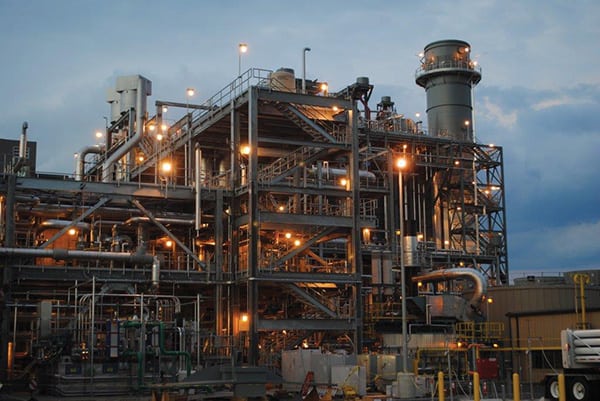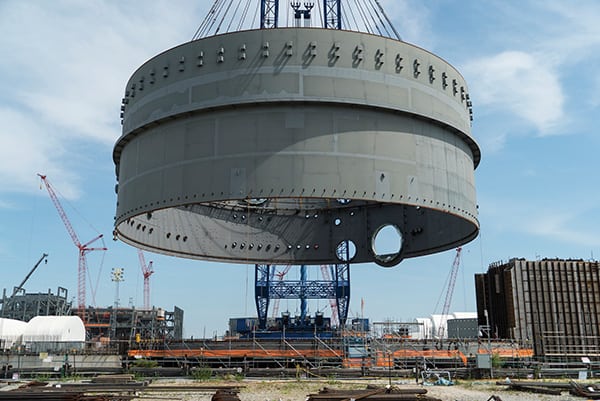Effectively managing time, budget, and resources has always been the goal of companies involved in constructing power generation projects, but today the challenges in meeting those goals can be greater than ever.
Any power generation company involved in new construction or an upgrade or retrofit project hopes it will see completion safely, without exceeding schedule or budget. But whether the project involves first-of-a-kind or familiar technology, it seems there are frequently project-specific complications to overcome. To learn what new tools and techniques construction firms are using to deliver successful projects, POWER reached out to half a dozen companies. Two, Kiewit and Fluor, responded. Both work on projects involving all fuel types, from fossil to nuclear to renewables.
Current Project Planning and Construction Challenges
In response to POWER’s question about the most significant current challenges in the power infrastructure construction business, Dave Flickinger, executive vice president of Kiewit Energy Group (Kiewit), whose headquarters are in Omaha, Neb., responded, “Speed-to-market is a top priority for our clients, who continue to challenge us with aggressive schedules that compress the overall duration from notice to proceed to the commercial operations date.”
At the same time, he added, “plant equipment is getting larger and more sophisticated, which can require longer lead times for design, coordination, and integration. We also remain steadfast in our commitment to safety and quality, which can affect project timelines. Fortunately, we have been able to counterbalance these impacts with new technologies that streamline our operations and maximize efficiency.”
Fluor, based in Irving, Texas, sees different challenges depending on the locale. Jack Penley, president of Construction & Fabrication, responded, “Globally, the most significant project challenge is reducing the capital costs of projects to enable them to move forward. In the current business climate, clients are cautious about deploying their capital to support new projects—they need cost and schedule certainty, with an improved rate of return, before they move forward with new investments.”
What drives those capital costs varies. In North America, demand for skilled craft professionals is a major factor. “In other locations,” Penley explained, “there may be available skilled labor, but if it is a remote area, there are other additional expenses, such as higher logistics and workforce housing costs.”
Working Smarter, Faster
Every firm in the construction business has some version of a productivity regime. Penley said Fluor has a “broad range of execution resources.” Every phase, from concept to commissioning and operations and maintenance, “is executed with a construction-driven mindset; for example, engineering and procurement activities are based on creating a better-build approach.”
One of those better-build approaches is what Fluor calls advanced work packaging (AWP). “AWP improves construction and productivity in the field through close engagement with engineering. Through intensive planning, starting in the front-end stage, the project determines the path of construction, developing engineering and construction work packages in accordance with the construction sequence and significantly improving efficiency.”
Fluor has used AWP on multiple projects in North America and has seen reductions in direct craft hours between 15% and 18%, as well as improved safety, schedule performance, and execution predictability. Penley said the company is currently implementing AWP on three power projects in the U.S. (Figure 1).
Kiewit also focuses on identifying ways to accelerate work in the early stages of a project, particularly in regard to procurement and engineering. For example, Flickinger said, “the faster we purchase equipment, the more quickly we can access critical technical information that influences engineering and design. Furthermore, the faster we can get engineering work complete, the faster we can get moving on construction.”
Throughout all phases of the project, productivity is key. “With careful analysis using cutting-edge technology we can significantly level manpower curves by trade,” he said. “Additionally, we use manpower and field density tools to ensure that work is sequenced as effectively as possible.”
Benefits of Modular Construction Not Fully Realized
Several years ago, modular construction techniques—especially for nuclear new builds—were touted as the latest and greatest innovation in power plant construction practices. When asked if modular techniques have lived up to their promise, the two firms gave somewhat different answers.
Fluor hasn’t seen a significant amount of modular construction on power projects, but believes “it holds tremendous potential for the power industry, based on the success we have seen in other industries, such as oil and gas,” Penley explained. “A significant portion of a power project, perhaps with the exception of the heat recovery steam generator, could be modularized.”
Fluor’s own, patented approach to modularization, called 3rd Gen Modular Execution, significantly increases the level of modularization on a project, reducing plot plan, onsite labor, and material requirements, Penley said. “On one oil and gas project, we were able to reduce the plot plan requirements by 40% versus a traditional design approach. On another project, use of 3rd Gen Modular Execution helped reduce the project’s capital costs by 30% from initial estimates.”
Kiewit’s Flickinger said, “In our experience, off-site modular construction has not proved to be cost effective. We have performed countless studies on various projects and have yet to find an opportunity where it makes sense. However,” he added, “we have utilized on-site modularization that has proved effective. Specifically, we have been able to better streamline the use of specialty craftsmen and, in many cases, reduced the amount of rework in the field.”
New Productivity Tools
As in power plants themselves, new automation tools and other technology-based solutions are making construction planning and execution more efficient and predictable.
“A well-planned project drives out work,” said Penley, “and, in addition to AWP and modularization, we have seen great improvements with automation tools to improve planning and field construction schedules.”
Scaffolding is another area where upfront planning can significantly reduce project costs, he added. “On a typical, large-scale industrial project, scaffolding can account for 20% to 40% of direct labor hours. By incorporating scaffolding into a project’s detailed design, scaffolding quantities and onsite productivity are optimized, with scaffolding hours potentially cut in half when compared to other projects.”
Fluor implemented this type of solution on the North West Redwater Partnership’s Sturgeon Refinery Project in Alberta, Canada, which was recently recognized with a Celebration of Engineering & Technology Innovation Award by Fiatech, an international organization dedicated to the betterment of the capital project industry. This solution can also be implemented on power projects, Penley said.
Other ways Fluor is striving to be more sustainable while improving project execution include developing a fully paperless construction project and seeing how innovations like 3-D printing can support projects.
Kiewit has developed a fully integrated, component-based tracking system that it says has been a game changer. “We have the ability to track the installation of each and every component that goes into the construction of a power plant—which can equate to more than 100,000 pieces,” Flickinger explained. “The system provides real-time insight on how installation aligns with our estimate and how that ties to our schedules. Beyond tracking past progress, it also allows us to analyze future manpower needs and sequence work over the short and long term.”
Drones are another tool Kiewit has used to solve project challenges. In mid-2013, Competitive Power Ventures (CPV) hired Kiewit to engineer, procure, construct, and commission Woodbridge Energy Center (WEC), a 725-MW combined cycle power plant in Woodbridge Township, N.J. (Figure 2). Completed ahead of schedule in January 2016, the plant met the owner’s budget and exceeded performance requirements thanks to innovation solutions that included using recycled wastewater for facility cooling needs and utilizing drone technology to plan and arrange site materials on a confined site.
 |
|
2. Eyes in the sky. Drone technology was used to plan and arrange site materials on the confined site of the new Woodbridge Energy Center in New Jersey. Courtesy: Kiewit |
Although the development area sits on more than 180 remediated acres, the WEC occupies only 27 of those acres, making for a tight workspace for such a large plant. One way the project addressed this complex challenge was by using drone technology to see exactly where to land materials, if the team was storing too much material in a certain place, or if materials could be consolidated.
Innovation can also be required for renewable power projects. On a recent large solar power project handled by Fluor, the grounding clips being used were difficult and time-consuming to install, which was affecting productivity in the field. Penley explained, “Our engineers partnered with a manufacturer to re-design a commercial, off-the-shelf grounding clip, increasing the installation efficiency of the more than 600,000 photovoltaic modules on the project. This innovative solution has since been used on other solar power projects, resulting in significant efficiency improvements.”
Workforce Training
A firm can have the latest, coolest technologies and processes, but without people, even “automated solutions” can’t get a project built, so it’s no surprise that both firms dedicate significant resources to their workforce.
“Our people are what separate us in our industry,” Flickinger said, “and we’ve worked hard to retain our employees through up and down cycles. While every company in our sector has experienced some workforce challenges, we’ve generally been able to hold our workforce number steady and add strong talent when needed.”
Flickinger attributes his company’s retention success to the significant investments made in training and development of staff and craft employees: Kiewit spends nearly $80 million on training and development annually—“well above the national average per employee.” That includes ongoing efforts on projects and through Kiewit University, a long-standing training center that provides more than 100,000 hours of training each year through a wide range of technical, leadership, and professional development curriculum. Construction on a new 62,000-square-foot Kiewit University building is under way in Omaha. The company also provides hands-on skilled training at its new center in Denver to support ongoing craft and staff employee needs.
Fluor is focused on training as well. “To develop our skilled craft workforce,” Penley said, “we offer training at every stage of a worker’s career, including free, entry-level training in four trades, after-hours skills upgrade training at our jobsites, welder upgrade training, and supervisory training.” At the recently completed Dominion Brunswick County Power Station project in Virginia, Fluor offered tuition-free, after-hours skills training to craft professionals. In 2015 alone, the company provided more than 12,000 hours of training at that site, in disciplines ranging from carpentry to pipefitting and welding.
Fluor also focuses on development of construction management professionals, placing new graduate employees immediately in field assignments. “Through this intensive rotational process, employees train under experienced superintendents and management, accelerating their understanding of our industry and ability to effectively manage work,” Penley explained.
“However, development alone will not solve all of the labor challenges,” he added, “which is why we are increasingly using techniques such as AWP and modularization to improve project efficiency. For example, with modularization, we can reduce onsite craft labor requirements. Fluor has fabrication yards located at five locations across the globe—by using these yards, we can fabricate modules where there is available labor and create cost and schedule advantages for our clients.” ■
—Gail Reitenbach, PhD is POWER’s editor.
https://www.powermag.com/new-best-practices-power-project-planning-construction/
https://www.yelp.com/biz/a-lumination-electric-orlando A-Lumination Electric
Claudette comments at 2024-01-10 01:48:01
https://www.yellowpagesdirectory.com/Orlando-FL/A-Lumination+Electric/1906857 A-Lumination Electric
Beth comments at 2024-01-10 09:10:59
https://www.google.com/maps/place/Coffin+Electric/@41.7677379,-93.7440776,10z/data=!4m6!3m5!1s0x87ec2976b5c38063:0x54b2dffb8402fafc!8m2!3d41.7677379!4d-93.7440776!16s%2Fg%2F11hbgsfly_?entry=ttu Coffin Electric
June comments at 2024-01-26 11:34:32
https://www.yellowpages.com/federal-way-wa/mip/handy-andy-restore-and-repair-573699771 Handy Andy Restore and Repair
Moshe comments at 2024-01-29 03:51:47
https://www.yelp.com/biz/a-lumination-electric-orlando A-Lumination Electric
Lynette comments at 2024-03-20 05:06:51
https://www.yelp.com/biz/handy-andy-restore-and-repair-seattle?adjust_creative=MFyzcjahxBMNAyHg85HGjg Handy Andy Restore and Repair
Maisie comments at 2024-03-21 04:11:42
https://www.yelp.com/biz/a-lumination-electric-orlando A-Lumination Electric
Alecia comments at 2024-03-22 07:20:24
https://www.google.com/maps/place/Handy+Andy+Restore+and+Repair/@47.3122708,-122.3438333,15z/data=!4m6!3m5!1s0x6d516079cbed0f4f:0x25d99b8e01e5c93f!8m2!3d47.3122708!4d-122.3438333!16s%2Fg%2F11rjytnwzw?hl=en-US&entry=ttu Handy Andy Restore and Repair
Abdul comments at 2024-03-30 07:48:47
https://www.yellowpages.com/nationwide/mip/coffin-electric-540977468 Coffin Electric
Ludie comments at 2024-04-02 14:15:47
https://www.yelp.com/biz/a-lumination-electric-orlando A-Lumination Electric
Keisha comments at 2024-04-04 00:53:03
https://www.yellowpagesdirectory.com/Orlando-FL/A-Lumination+Electric/1906857 A-Lumination Electric
Shawna comments at 2024-04-04 08:59:36
https://www.yellowpagesdirectory.com/Orlando-FL/A-Lumination+Electric/1906857 A-Lumination Electric
